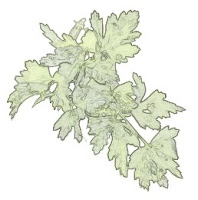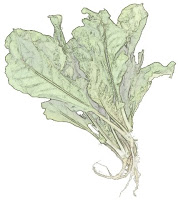So do raised beds qualify as container gardens? I think they do. You can construct them cheaply and easily, they can be set up on top of manmade surfaces, and offer an easily maintained, highly productive growing area free of weeds and digging in minimal space.
Most container gardeners, of course, limit themselves to containers because they are apartment dwellers with extremely limited outdoor space. If you've turned to containers because the thought of tilling your hideous backyard soil is too repulsive, or you do have a small green or paved area to call your own, or you even know someone (perhaps a parent or very patient friend) with a large yard who might be willing to lend you a little well-lit space, a homemade raised bed could be the perfect halfway-house between container and free range gardening.
I've thought a great deal lately about the economics of container gardening. More to the point, I've been crunching numbers on how to actually save money from growing your own vegetables, Great Depression-style. Too many gardeners add up the numbers at the end of the season to find they've shelled out $65 per Heirloom Brandywine. However beautiful their gardens might be, it's fairly easy to coax untold bushels of produce out of the ground if you've got plenty of money and space.
Tomatoes are the most ubiquitous of home-grown vegetables. They taste amazing when you grow them yourself or buy them locally, and like complete crap when you buy them at the supermarket. I decided to use tomatoes as my financial bellwether. Was it possible to grow your own for less than supermarket prices, while getting Farmer's Market flavor? Tomatoes at the supermarket cost about $1 per pound; at the Memphis Farmer's Market, about $3 per pound. Was it possible to construct- and to provide instructions on how to construct- a fully-functional container vegetable garden that provided at least 200 pounds of tomatoes for under $150?
Let's find out. Although I based my calculations on the Tomato Financial Index (TFI), this method will yield not only 324 pounds of tomatoes, but could instead be used to grow 100 pounds of melons, 108 eggplants, 200 peppers, or 106 pounds of potatoes per 3' x 6' raised bed.
For our Financial Victory Garden, we'll have neither money nor space in great supply. You will need a screwdriver and plenty of gumption, however.
1. FIND A SPACE
We'll be constructing a raised bed on either grass (the easy way) or on top of a preexisting surface (the slightly-less-easy way). The layout of that space is not important. Is it six feet long and eight inches wide? No problem. Two feet by two feet? Not an issue. All it truly needs to have is:
- Plenty of sunlight (at least six hours a day of unobstructed light: no shade, no dappling through leaves, no exceptions)
- A flatish, ground-level surface. This can be actual ground or a concrete/brick/paving stone manmade surface. A slight grade is fine, but don't try to build this on a steep hillside. The sunny patio where you keep your container garden is ideal.
2. CALCULATE THE SIZE OF YOUR BEDS
The raised bed will be constructed out of four wooden two-by-fours held together at each corner with a metal corner connector. The corner connectors can be fancy and made for this purpose specifically by a gardening supply house, or generic and purchased at Home Depot for half the price.
Get out your trusty measuring tape and measure the length and width of your space. The following instructions assume you're going to build one bed that's 6 feet long and 3 feet wide. If you only have space for a 3' x 3' bed, that's a great starting point; just halve the quantities listed here. If you need to break it up into two 3' x 3' beds, that will work just as well.
3. PURCHASE YOUR MATERIALS
For each bed, you'll need to go to Home Depot and get:
Wood Slats:
- 2 lengths of two-by-fours, cut for the long ends of the bed (they'll make the cuts for you for about $1 per cut); about $10 total, depending on length
- 2 lengths of two-by-fours, cut for the short ends of the bed; about $10, depending on length
Corner Connectors
- If you're placing the bed in grass or dirt, get four rigid tie connectors for $4.49 each. TOTAL = $17.96
- If you are placing the beds on a manmade surface, get four standard angles for $1.09 and a supply of plastic sheeting as wide (plus eight inches) and long (plus eight inches) as your bed, about $30. TOTAL = $34.36
- If you feel flush with money, get your connectors from Gardener's Supply Company, in your choice of depth (10" is a good starting point). $16.95 for two; you'll need four. TOTAL = $33.90
TOTAL = about $30
Screws: At least 16 screws to fit the holes of the angles you've purchased; about $.50
TOTAL = $.50
Soil: Enough garden soil, compost, growing mix, and fertilizer to fill your bed.
- Garden Soil: $7.47 per bag; one bag per 2 cubic feet
- Compost: $7.99 per bag ('Nature's Blend' at local garden center, Stringers); one bag per 2 cubic feet
- Soil-less Growing Mix: $12.47 per bag; one bag per 2.5 cubic feet
- Vegetable Food or Fertilizer: $8.98 per 5-pound box
For a 3' x 6' raised bed that's 10" deep, you'll need
- 12 cubic feet of garden soil (that's six 2-cubic-feet bags) = $44.82
- 6 cubic feet of compost (that's three 2-cubic-feet bags) = $23.97
- 2 cubic feet of soil-less growing mix like ProMix (that's one 2.5-cubic-feet bag) = $12.47
- 5 pounds of vegetable fertilizer (one 5-pound box) = $8.98
To calculate the soil needs of a 3' x 6' x 10" bed:
3 feet long x 6 feet wide x .83 feet deep x 1.33 = about 20 cubic feet of total soil
To calculate your soil needs:
length in feet of bed x width in feet of bed x depth in feet of bed x 1.33 = ___________ cubic feet of total soil needed
Or use the Soil Calculator at Gardener's Supply Company (cheater).
4. CONSTRUCT THE RAISED BEDS
If you've purchased your corner connectors from Gardner's Supply, they came with an easy-to-follow set of instructions. If you've purchased them at Home Depot:
- Grab one of your long wooden slats and one of your short wooden slats. Using a screwdriver or drill, attach them to the corner connector so that they form an 'L'. Make sure you get these corners as square as possible; a right-angle or T-square measure would be very useful here.
- Repeat with the remaining two sides
- Screw the two 'L's to one another using the remaining two connectors, so that they form a rectangle.
- OPTIONAL: If you're placing the bed on a manmade surface (concrete, bricks, etc.) or uneven natural surface, place your bed where you want it and unroll your black sheeting. Fit the black sheeting into the bottom of the bed and then staple it to the wood along the top (or top lip) of the bed, making sure you fold the sheeting in the corners so that soil doesn't trickle out. Grab a pair of scissors and trim the excess black plastic from the top of the bed. Then, using the scissors, snip small (half an inch long) holes in the bottom of the sheeting for drainage. Try to be methodical; a grid pattern of a snip every two to three inches ought to do it. All this will keep your soil from washing out of the bottom of the bed when you water, and will help keep the bed moist but well-drained.
- Congratulations, you're done!
5. FILL THE BEDS
Empty your garden soil, compost, grow mix, and fertilizer into your beautiful raised bed. Mix until you're thoroughly exhausted and contents are evenly distributed. Smooth the top with a rake or your hands. Stand back, admire your handiwork, and drink at least two beers.
You've done it! Your bed is ready and you may now fill it up with any plant species that takes your fancy.
6. CHOOSE YOUR PLANTS
As a general rule, put in one vegetable plant per square foot. If you have a 3' x 6' bed, that's three rows and 6 columns for a total of 18 spaces (3 x 6 = 18). If you have a 3' x 3' bed, that's a total of 9 space (3 x 3 = 9).
You can purchase your new plants at Home Depot, but don't forget to check out your local garden center for more exotic varieties. Farmer's markets- here in Memphis, that includes the Memphis Farmer's Market and the Botanic Garden Farmer's Market- will also have an excellent selection with a much greater-than-Home-Depot chance of survival in your area. Good heirloom plants will cost about $4 each.
TOTAL (18 plants) = $72
Don't forget: choose vegetables you actually want to eat.
7. LAYOUT IDEAS
Don't be afraid to experiment, however. For example, if you're hell for Italian cooking, create your own
Italian Chef's Garden:
- 5 squares of tomatoes
- 4 squares of eggplants
- 2 squares of basil (2 plants per square)
- 2 squares of garlic (4 plants per square)
- 2 squares of parsley (2 plants per square)
- 1 square of rosemary
- 2 squares of yellow squash
Do you want to harvest nothing but tomatoes? Fine. Your visions of canning your own tomato pickles or creating the World's Finest Homemade Ketchup, of perfecting your grilled tomato kebab recipe can be a reality. Knock yourself out. It's your garden, your hard work, and completely up to you.
Ultimately, though, I promised that the point of your Financial Victory Garden is to feed yourself for less than you would have paid at the store. We have to be hard-nosed realists: have we managed to do that?
Wood: $20
Connectors: $30
Screws: $.50
Soil: $90.24
Plants: $72
RAISED BED GRAND TOTAL: $212.74 for a potential yield of 324 pounds of tomatoes
Store price: $324 for 324 pounds of tomatoes
Farmer's Market price: $972 for 324 pounds of tomatoes
Cheap, functional, and one of the funnest ways to spend time outside in the Spring: hopefully nothing will stop you from creating your own raised bed container garden.

















